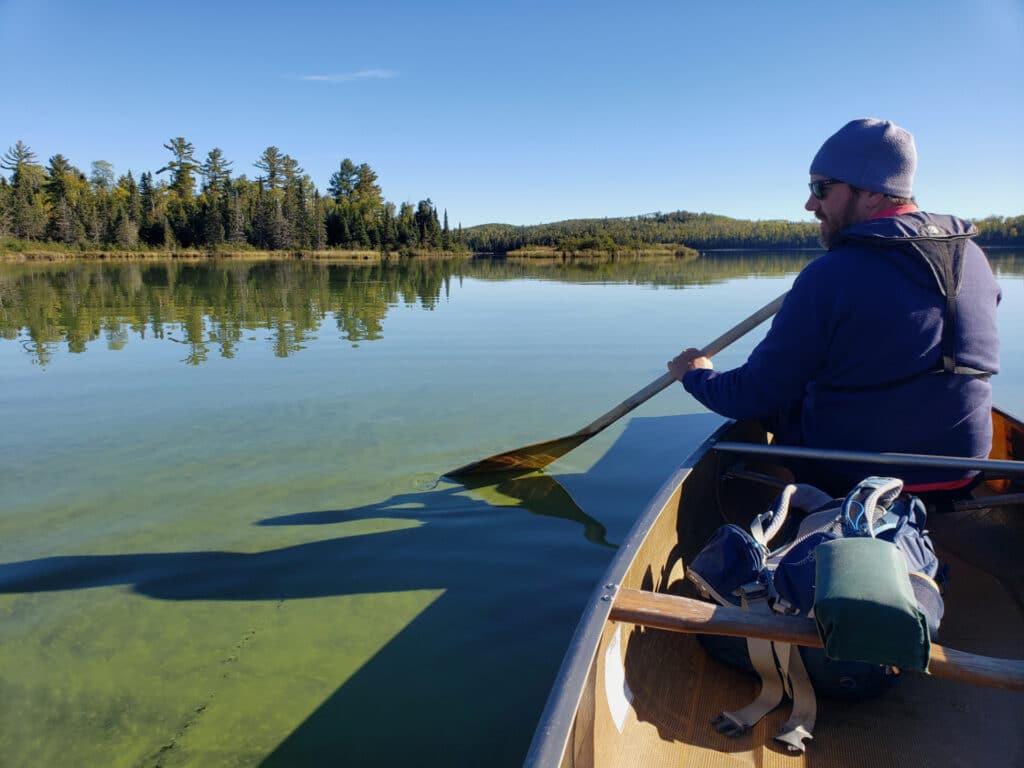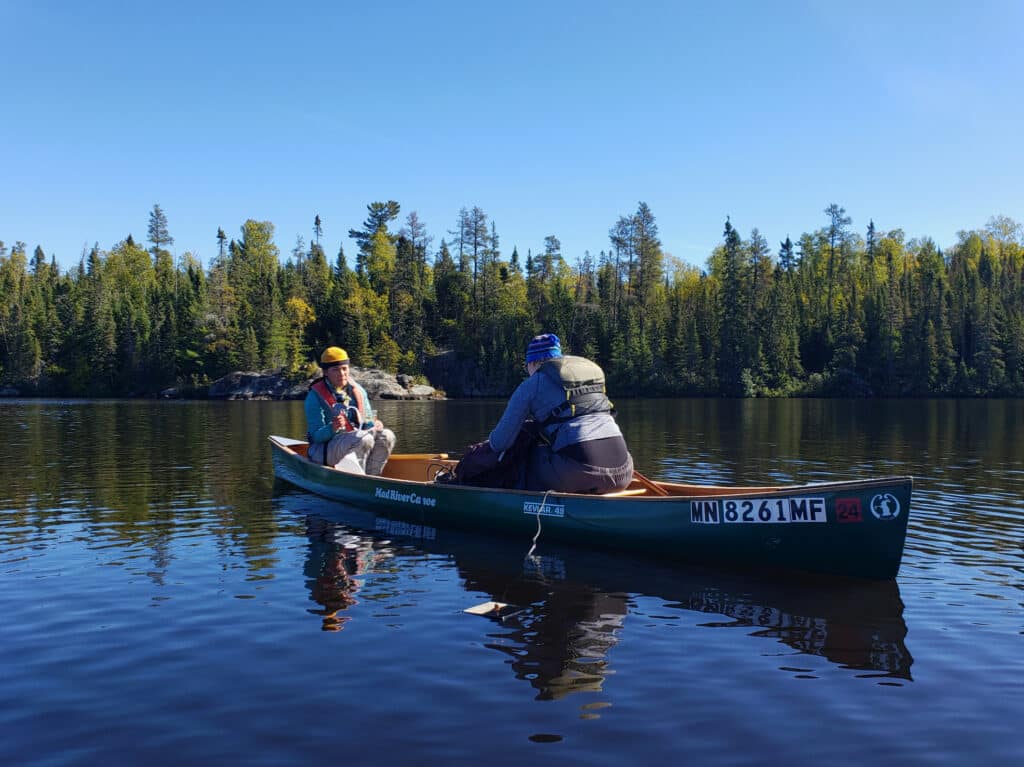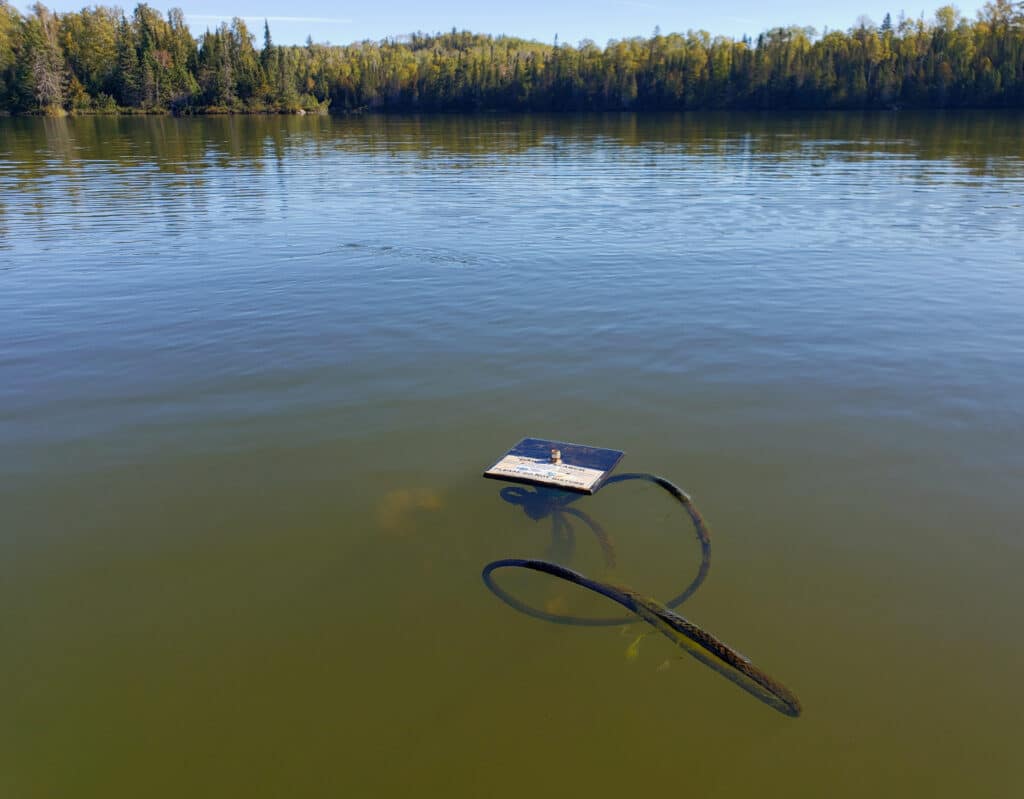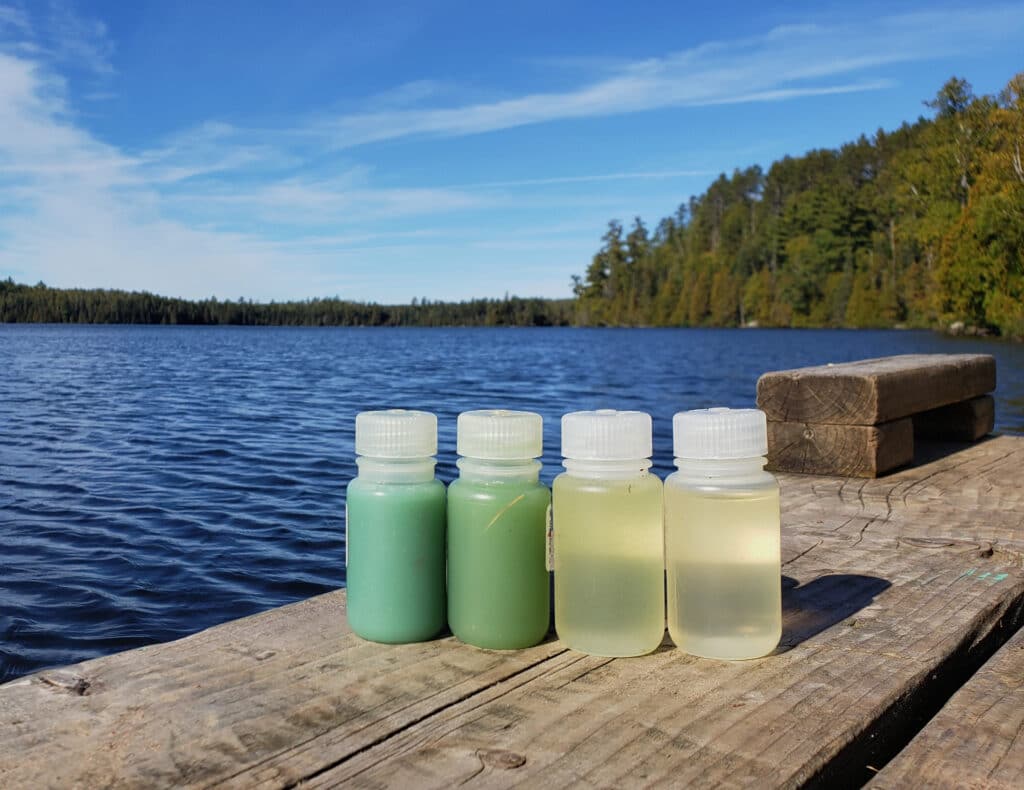EXCLUSIVE 2-PART FEATURE:

The crew was quickly to the first portage, a 100-rod footpath (about a third of a mile) over to Smoke Lake. I took the first turn carrying the canoe on my shoulders, traversing the typical trail of rocks and tree roots through dense forest. It gave me a chance to think about how the highly skilled work of this study is matched by the physical effort required. The scientists have PhDs and experience working on waters around North America, but they must also be ready to paddle and portage, face rain and sun, bugs and wind, and repeatedly perform laborious tasks that require both precision and brute strength.
Soon enough we were afloat again on the other end of the portage — and then we were paddling through green slime. The cyanobacteria in a shallow bay on the west side of the lake was ten times thicker than on Sawbill. The sun was hitting the water now, and the organisms were soaking it up. We paddled to the lake’s study site, where we could see the top of the monitoring buoy that had been deployed in June.
In this spot, near the deepest point in the lake, there was little sign of cyanobacteria. It’s one of the many difficulties in studying these blooms, which can be isolated to one part of a lake and last for a short time each day, and each season. But by rigorously taking measurements at the same sites, the overall condition of the lakes can be monitored, and reliably connected to the forces at work. Lienne and Amelia clipped an anchor line to the buoy so they would stay in place, and set to work.
The scientists had a well-crafted routine to gather all the information they needed. Water was collected, some stowed away in small bottles, others pumped through specialized filters to collect samples for DNA analysis. The levels of toxic chemicals from cyanobacteria would also be measured, to determine the link between the organisms and their harmful byproducts.
Sometimes the work was tedious, as everything had to be painstakingly labeled and organized. Pumping water through the tight filter membranes several times, each a little tougher than the last, got hard on the hands. But it meant sitting in a canoe in the middle of a beautiful wilderness lake on a calm autumn morning, and there were no complaints.

Subtle changes
After another portage we arrived at Burnt Lake, where the water was also green. It was simply soupy near the portage. Big cyanobacteria blooms are said to look like green paint spilled on the water, like a sludge that sits on top of the surface. This was a textbook case.
There have been reports of cyanobacteria blooms on Burnt and Smoke Lakes for nearly a hundred years, according to the owners of nearby Sawbill Outfitters. The current owners’ grandparents founded the business in 1957, and say the lakes experienced blooms as far back as the 1930s.
Such oral history is highly valued by the researchers, and the study can add a lot of context. Some types of cyanobacteria bloom without producing toxins, and thrive in different lake conditions. It’s possible that this is happening in northern Minnesota, with blooms appearing the same but potentially more toxic and with greater impacts on the ecosystem. Nutrient levels, climate, and even carbon dioxide levels are changing, and all those forces can affect which species dominate. Previous research conducted by the Science Museum has found that’s precisely what’s happening on northern Minnesota’s vast Lake of the Woods: Another lake that has historically had cyanobacteria blooms, sediment cores have shown how changing climate and nutrient ratios caused entirely new types of algae to become the dominant strain in recent years.
The team did not collect cores on the wilderness lakes today, though. Because there are no motors allowed on these Boundary Waters lakes, and because taking a sediment core out of canoes is difficult at best, the researchers will return this winter to ski in, camp overnight, and take cores through holes in the ice.

The last study lake was Flame Lake, a shorter portage north of Burnt. A couple of campers we met coming down the trail were bursting to tell us about the aurora borealis they had witnessed from the lake’s sole campsite a few nights before, when unbelievable colors had danced in the sky.
Flame was just blue, though. Not orange of fire, nor red of northern lights, nor blue-green of cyanobacteria. There was some visible cyanobacteria in small areas near shorelines, and samples were collected, but the water was mostly clear like typical canoe country lakes, and reflected the bright periwinkle sky. This drastic different body of water will hopefully offer an informative comparison to the badly blooming lakes nearby.
On our way back to the landing, retracing our route, we passed again through western Burnt Lake. The cyanobacteria bloom was at its peak, with the namesake blue of the algae starting to show as the algae cells began to die back. Adam said it was the biggest bloom he’d ever seen on any lake, including his home state of Iowa. It appeared nearly solid on the surface. It dragged at the hull of the canoe as we paddled through it.
The team collected water and algae for later toxin analysis. Back at the lab, they found the water along Burnt Lake’s shoreline contained 180 times the safe drinking water level, and six times above what’s considered safe for swimming and other recreation. The chemical found, microcystin, can badly damage the human liver.
Then we picked up our canoes and gear and portaged on, backpacks bulging with samples.

Sensitive systems
While the field work was done for the day, the search for answers was only beginning. Northern Minnesota’s lakes are highly sensitive to minor changes in the environment, and this study is seeking to understand just how vulnerable they are.
In fact, the clear, cold, low-nutrient lakes of northern Minnesota are more sensitive than most. Adding a small amount of phosphorus or nitrogen, or slight change in climate, to a lake that is already rich in nutrients usually doesn’t have a significant impact, because it’s just a drop in the bucket for everything that causes cyanobacterial blooms. But even relatively small changes in a lake that historically has little in the way of nutrients, and which doesn’t have a lot of plant growth, can have major effects that ripple through its ecosystem.
The researchers paid one more visit to the lake in October, once again weathering wind and cold and rain to collect their data. Data collected by the lake monitoring buoys over the summer was downloaded, but the buoys will stay in the lakes over the winter, covered by a couple feet of ice so that they’ll be in place just before freeze-up and after ice-out. The lakes are essentially inaccessible in this shoulder season, unsafe for travel by foot or boat, but the buoys will let the scientists see important seasonal changes during these critical transition periods for lakes.
This winter, the research team will run the samples through laboratory tests and computer models, beginning to build a picture of these lakes, how they are different, how they are the same, and how they are changing.
More information:
- St. Croix Watershed Research Station – Science Museum of Minnesota
- Boundary Waters algae blooms spark questions, concern – MPR News

